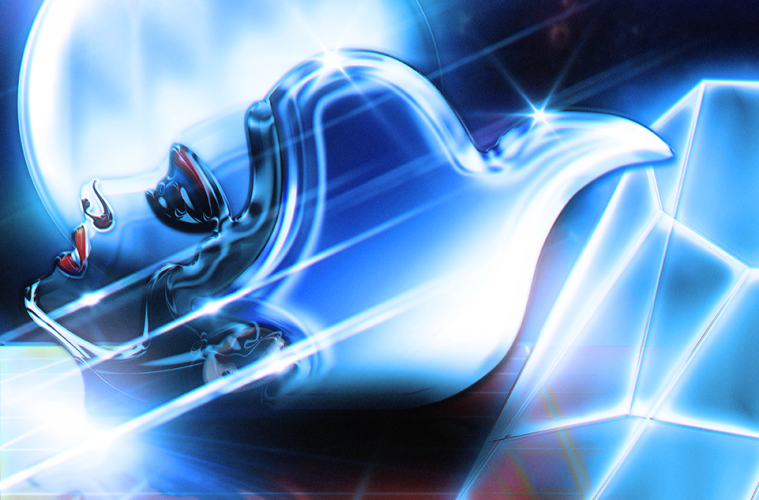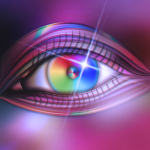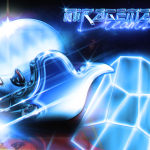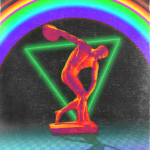For the past half decade the 1980’s and 1990’s are cool again. Bold colors, abstract design, and synth powered tunes are here to grab our eyes and ears. VHS and proto internet culture are here to take us to magical places that haven’t existed for decades. And nothing captures this movement like the Vaporwave and Retrowave music scenes. That is, despite no other than VICE asking if the scene was dead. Having read that piece, and seeing what artists like Tim Waves are doing in that space right now, being dead looks pretty damn fun.
But I am getting ahead of myself. Tim Waves, a.k.a Miragem23, has created cover art for records, most notably for Werkstatt Recordings and bands like Stilz. Waves is able to create arresting, colorful images that cut like a knife into the part of the brain that craves nostalgia while bringing something new and different to the space. In short, he is worth your attention.
What follows is an in depth interview of Waves’ work process, influences, and the art itself.
AAGG: When did you decide to become a designer?
WAVES: Since ever, I have always been involved with art. Always loved music, learned to play guitar when I was 11-years-old by myself and since this time started to compose my songs. The visual arts were no different…always loved to draw, like all children, but never stopped doing it. Actually, I always appreciated the area of creativity, so it was a natural process.
AAGG: Did you have any formal training as a graphic designer? If so, where did you go to school?
WAVES: I graduated with degrees in philosophy and fine arts, in that order. But this combination, added with my passion by creation and digital art processes, made it possible to go into this field. Both courses were taken at a federal university in Rio de Janeiro, Brazil, where i was born and I’ve always lived, even today.
AAGG: What tools do you use to create your art?
WAVES: Basically Adobe Photoshop. In rare cases I use Adobe Illustrator, and only for typography. Also, sometimes I sketch something on paper before taking it to the computer, but I am much more tuned into the digital process.
AAGG: You’re a musician as well. How did you get involved in the Vaporwave/Retrowave scene?
WAVES: It is an interesting question. When I finished graduation I was totally involved with projects of culture jamming, conceptual art, dadaism, and I was in a period of a strong spiritual quest, learning and practicing Zen Buddhism, some other ancient oriental philosophies and some contemporary free and decentralized religions. This background made me look for artistic expressions genuinely arising from the internet, a peculiar technology of our time. I was taken then by Vaporwave, which has a strong appeal in all these areas. Afterwards, I gradually entered the Retrowave/Synthwave scene and [have been] shaping my work for the public.
AAGG: It is very interesting that you mention Dadaism. What artists from that period inspired you? And what influence do you think Dadaism had on the 80’s and the art of today?
WAVES: Dada works do not attract me much, visually speaking, because it is/was an anti-art movement, so, the visuals can be very subversive sometimes, in relation to the works shape. But I love the concept and I can’t fail to mention Marcel Duchamp, the main founder of this school. I think that the influence in 80’s was strong specially by this subversive nature in the relationship with the form. And today that continues shaping the market for art and pop culture. It’s very much in line with the Dadaist concepts. So, gradually, we can see vaporwave visuals reaching TV shows and video music in the mainstream, as examples, but embellished under some visual prerogatives, to get pop appreciation. But now, when talking about the high dollar art market it is weird that the same elite which long time venerated a specific type of art today is paying a fortune for anti-art works, because the majority of “conceptual art” produced today actually is totally free of concept. It is not like the Hegelian thinking about art that is supposed to reach a superior idea, but something totally subversive with art and ideas simultaneously. But it is all very complex at that point.
 Miragem23 Art
Miragem23 Art
AAGG: What advice would you give to up and coming artists?
WAVES: I think in any area of art, be it retrowave or not, is the novelty of what the public are always looking for. Specifically about retrowave, you know, this area is not made by old stuff, but by new and fresh stuff inspired by a style of a period or a decade. So, to have some prominence, the artist needs to present some new and unique things. [You] need to find your own style and show it to the public. I am not talking about originality, but about a expression of your own self, which is constructed by a number of external references, cultured for all life, but results in a mixture which is a final product that is totally unique.
AAGG: As an artist, what would you say are your biggest influences? Whose work do you admire most?
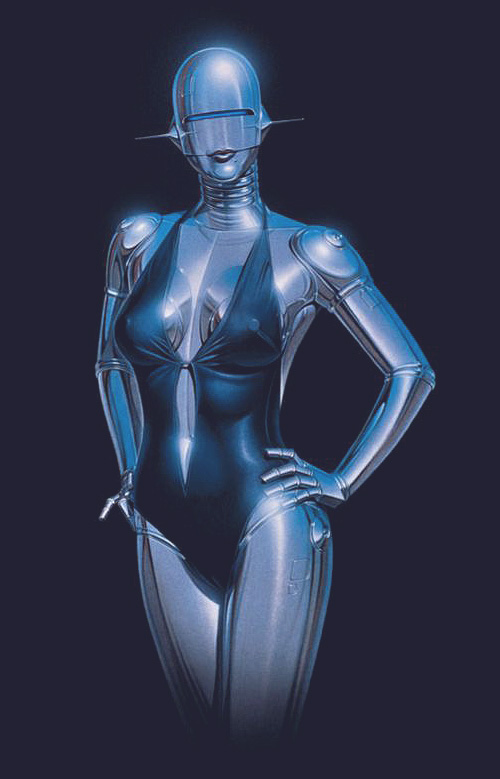 An example of the works of Hajime Sorayama
An example of the works of Hajime Sorayama
WAVES: I see the 80’s as a time of subversion on art. We have a lot of examples of oddity in visuals and music. Even the Memphis design, one of my biggest references, had as its main proposal unlink design and utility, making the form autonomous, independent. So, we have as example, a chair that is impossible to sit on, but beautiful to see. This subversion provided one of the richest decades, artistically speaking. Beyond Memphis design, I totally love the type of art of the eighties that have some surrealism, like the work of Pater Sato, and sci-fi related like Hajime Sorayama and Ichimatsu Meguro.
AAGG: Are there any particular movies/comics/music that influence your art?
WAVES: Yeah. [It] will sound a bit cliché, but Tron [had an] aesthetic that I totally love. Also Altered States by Ken Russell. And The Holy Mountain by Alejandro Jodorowsky. It is a movie from the 70’s, but it inspired me because of the surrealism and the great colors. [I] never was very tuned into comics. And music, you know, all the pop stuff of the 80’s is great! But actually I am always being influenced by everything that my senses can experience.
 Miragem23 art (and my favorite piece 😉
Miragem23 art (and my favorite piece 😉
AAGG: What are you excited about reading/watching when you have some spare time?
WAVES: I love to read poetry. It’s a type of sublimation by words. My preferred poets are Fernando Pessoa, Augusto dos Anjos and Florbela Espanca. All these are Portuguese writers and I don’t know if they [were] translated to English. And I love to read philosophy books. Now I am rereading Critique of Pure Reason, by Immanuel Kant. I never was a fan of fictional literature. In regards to “watching” things, I like to watch lectures about diversified subjects on Youtube. Movies and series are something that I watch rarely.
AAGG: What trends do you see coming down the road? What is coming out in the future that you are excited about?
WAVES: The main art market is, undoubtedly, composed of conceptual pieces. It is because, for some time, the artists are most interested in the ontological nature of the process. But it is an elite niche. Popular art has always been and always will be figurative art. Especially talking about the retrowave scene, the retro visuals have always had its place. This is explained by a feeling of nostalgia that people have with the past. But now, the artists that are shaping the retro scene are guys that were children in the 80’s and 90’s, so this is the new trend for the retro art of our time, and, for sure, I am very excited with this!
ACTION A GO GO would like to thank Tim Waves for taking the time to interview with us. He does work for commission and can be reached at the links provided.

